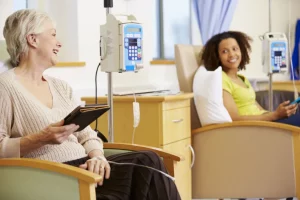
Most patients with stage 4 ovarian cancer have disease that has already spread and cannot be removed with surgery, so systemic treatment that can kill cancer cells throughout the body is necessary.
Treatment focuses on extending life and maintaining quality of life.
Systemic treatment is called chemotherapy. Chemotherapy can also destroy cancer cells that have metastasized to parts of the body away from the original tumor site. Combining two or more chemotherapy agents can be used for treatment of ovarian cancer, as this will help to provide a better response overall.
Chemotherapy schedule
Chemotherapy is usually given over 3-6 months. It’s given in cycles, with days or weeks off between treatments. This gives your body a chance to recover.
Most chemotherapy is given by IV through a vein and you will usually need to have a port placed. Some chemotherapy treatment is in pill form and can be taken orally.
Your schedule depends on the combination of drugs used for treatment.
Chemotherapy for epithelial ovarian cancer
Chemo for ovarian cancer usually involves getting two different types of drugs together. Usually, the combination includes a type of chemo drug called a platinum compound (usually cisplatin or carboplatin), and another type of chemo drug called a taxane, such as paclitaxel (Taxol®) or docetaxel (Taxotere®). These drugs are usually given as an IV (put into a vein) every 3 to 4 weeks.
The typical course of chemo for epithelial ovarian cancer involves 3 to 6 cycles of treatment, depending on the stage and type of ovarian cancer. A cycle is a schedule of regular doses of a drug, followed by a rest period. Different drugs have varying cycles; your doctor will let you know what schedule is planned for your chemo.
Some of the other chemo drugs that are helpful in treating ovarian cancer include:
- Albumin bound paclitaxel (nab-paclitaxel, Abraxane®)
- Altretamine (Hexalen®)
- Capecitabine (Xeloda®)
- Cyclophosphamide (Cytoxan®)
- Etoposide (VP-16)
- Gemcitabine (Gemzar®)
- Ifosfamide (Ifex®)
- Irinotecan (CPT-11, Camptosar®)
- Liposomal doxorubicin (Doxil®)
- Melphalan
- Pemetrexed (Alimta®)
- Topotecan
- Vinorelbine (Navelbine®)
Intraperitoneal (IP) chemotherapy
For women who have advanced ovarian cancer and whose cancers were optimally debulked (no tumors larger than 1 cm after surgery), intraperitoneal (IP) chemotherapy might be given in addition to systemic chemo (paclitaxel given in a vein).
In IP chemotherapy, the drugs cisplatin and paclitaxel are injected into the abdominal cavity through a catheter (thin tube). The tube can be placed during the staging/debulking surgery, but sometimes it is placed later. If it is done later, it can be placed by a surgeon using laparoscopy, or by an interventional radiologist under x-ray guidance. The catheter is usually connected to a port, a half dollar-sized disk topped with a pliable diaphragm. The port is placed under the skin against a bony structure of the abdominal wall, such as a rib or pelvic bone. A needle can be placed through the skin and into the port to give chemo and other drugs. Giving chemo this way provides the most concentrated dose of the drugs directly to the cancer cells in the abdominal cavity.
Chemotherapy for germ cell tumors
If you have a germ cell tumor, you will likely be treated with combination chemo (several different drugs at once). The combination used most often is called BEP, and includes the chemotherapy drugs bleomycin, etoposide and cisplatin (Platinol). If the cancer is a dysgerminoma, these are usually very sensitive to chemotherapy, and can sometimes be treated with the less toxic combination of carboplatin and etoposide. Other drug combinations may be used if the cancer isn’t responding to treatment or to treat cancer that has recurred (come back). These include:
- High dose chemotherapy (the exact drugs used can vary depending on what cancer center is giving the treatment)
- TIP (paclitaxel/Taxol, ifosfamide, and cisplatin/Platinol)
- VeIP (vinblastine, ifosfamide, and cisplatin/Platinol)
- VIP (etoposide/VP-16, ifosfamide, and cisplatin/Platinol)
- VAC (vincristine, dactinomycin, and cyclophosphamide)
Chemotherapy for stromal tumors
Ovarian stromal tumors are not often treated with chemotherapy, but when they are, the combination of carboplatin plus paclitaxel or PEB (cisplatin/Platinol, etoposide, and bleomycin) is used most often.
Hormone Therapy for Advanced Ovarian Cancer
Luteinizing-hormone-releasing hormone (LHRH) agonists
- Goserelin (Zoladex®)
- Leuprolide (Lupron®).
- Tamoxifen
Aromatase inhibitors
- Anastrozole (Arimidex®),
- Exemestane (Aromasin®).
- Letrozole (Femara®)
Chemotherapy can also be used in combination with immuno-oncology or immunotherapy and hormone therapy and some advanced ovarian cancer may benefit from therapy or a combination of therapies. A multidisciplinary treatment team is important for every patient!




